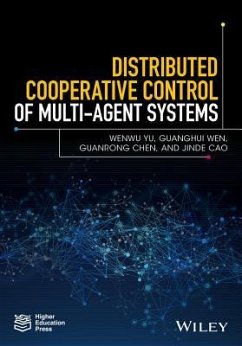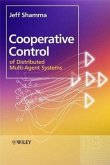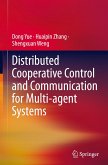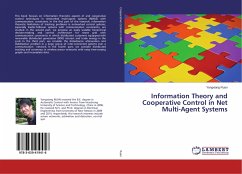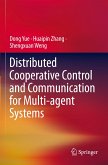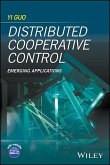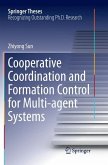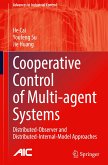Wenwu Yu, Guanghui Wen, Guanrong Chen, Jinde Cao
Distributed Cooperative Control of Multi-Agent Systems
Wenwu Yu, Guanghui Wen, Guanrong Chen, Jinde Cao
Distributed Cooperative Control of Multi-Agent Systems
- Gebundenes Buch
- Merkliste
- Auf die Merkliste
- Bewerten Bewerten
- Teilen
- Produkt teilen
- Produkterinnerung
- Produkterinnerung
A detailed and systematic introduction to the distributed cooperative control of multi-agent systems from a theoretical, network perspective * Features detailed analysis and discussions on the distributed cooperative control and dynamics of multi-agent systems * Covers comprehensively first order, second order and higher order systems, swarming and flocking behaviors * Provides a broad theoretical framework for understanding the fundamentals of distributed cooperative control
Andere Kunden interessierten sich auch für
![Cooperative Control of Distributed Multi-Agent Systems Cooperative Control of Distributed Multi-Agent Systems]() Jeff Shamma (ed.)Cooperative Control of Distributed Multi-Agent Systems225,99 €
Jeff Shamma (ed.)Cooperative Control of Distributed Multi-Agent Systems225,99 €![Distributed Cooperative Control and Communication for Multi-agent Systems Distributed Cooperative Control and Communication for Multi-agent Systems]() Dong YueDistributed Cooperative Control and Communication for Multi-agent Systems104,99 €
Dong YueDistributed Cooperative Control and Communication for Multi-agent Systems104,99 €![Information Theory and Cooperative Control in Net Multi-Agent Systems Information Theory and Cooperative Control in Net Multi-Agent Systems]() Yongxiang RuanInformation Theory and Cooperative Control in Net Multi-Agent Systems40,99 €
Yongxiang RuanInformation Theory and Cooperative Control in Net Multi-Agent Systems40,99 €![Distributed Cooperative Control and Communication for Multi-agent Systems Distributed Cooperative Control and Communication for Multi-agent Systems]() Dong YueDistributed Cooperative Control and Communication for Multi-agent Systems104,99 €
Dong YueDistributed Cooperative Control and Communication for Multi-agent Systems104,99 €![Distributed Cooperative Control Distributed Cooperative Control]() Yi GuoDistributed Cooperative Control114,99 €
Yi GuoDistributed Cooperative Control114,99 €![Cooperative Coordination and Formation Control for Multi-agent Systems Cooperative Coordination and Formation Control for Multi-agent Systems]() Zhiyong SunCooperative Coordination and Formation Control for Multi-agent Systems75,99 €
Zhiyong SunCooperative Coordination and Formation Control for Multi-agent Systems75,99 €![Cooperative Control of Multi-agent Systems Cooperative Control of Multi-agent Systems]() He CaiCooperative Control of Multi-agent Systems171,19 €
He CaiCooperative Control of Multi-agent Systems171,19 €-
-
-
A detailed and systematic introduction to the distributed cooperative control of multi-agent systems from a theoretical, network perspective * Features detailed analysis and discussions on the distributed cooperative control and dynamics of multi-agent systems * Covers comprehensively first order, second order and higher order systems, swarming and flocking behaviors * Provides a broad theoretical framework for understanding the fundamentals of distributed cooperative control
Produktdetails
- Produktdetails
- Verlag: Wiley
- Seitenzahl: 350
- Erscheinungstermin: 1. Mai 2017
- Englisch
- Abmessung: 244mm x 160mm x 18mm
- Gewicht: 544g
- ISBN-13: 9781119246206
- ISBN-10: 1119246202
- Artikelnr.: 48384287
- Herstellerkennzeichnung
- Libri GmbH
- Europaallee 1
- 36244 Bad Hersfeld
- gpsr@libri.de
- Verlag: Wiley
- Seitenzahl: 350
- Erscheinungstermin: 1. Mai 2017
- Englisch
- Abmessung: 244mm x 160mm x 18mm
- Gewicht: 544g
- ISBN-13: 9781119246206
- ISBN-10: 1119246202
- Artikelnr.: 48384287
- Herstellerkennzeichnung
- Libri GmbH
- Europaallee 1
- 36244 Bad Hersfeld
- gpsr@libri.de
Wenwu Yu, Southeast University, China, received his Ph.D. degree from the Department of Electronic Engineering, City University of Hong Kong, in 2010 and is currently a full Professor in the Research Center for Complex Systems and Network Sciences. He is the author or coauthor of about 100 refereed international journal and conference papers with more than 3400 citations, and a reviewer of several journals. His research interests include multi-agent systems, nonlinear dynamics and control, complex networks and systems, neural networks, cryptography, and communications. Guanghui Wen, Southeast University, China,received the Ph.D. degree in mechanical systems and control from Peking University, China, in 2012. From September 2012 to January 2013, he was a Research Associate and Post-Doctor in the University of New South Wales at Australian Defence Force Academy, Australia. Currently, he is a Lecturer in the Department of Mathematics, Southeast University, China. His research focuses on cooperative control of multi-agent systems and cyber-physical systems. Guanrong Chen, City University of Hong Kong, China, has been a chair professor and the founding director of the Centre for Chaos and Complex Networks at City University of Hong Kong since year 2000, prior to which he was a tenured full professor at the University of Houston, Texas, USA. Prof. Chen was elected Member of the Academia Europaea in 2014. In the past, he was elected IEEE Fellow in 1997, and was conferred Honorary Doctorates by Saint Petersburg State University of Russia in 2011 and by University of Le Havre of France in 2014. Other honours include the 2011 Euler Gold Medalist and the 2008 and 2012 Chinese State Natural Science Awards as well as 5 best journal paper awards. He is Honorary Professor at different ranks in some 30 universities worldwide. Prof. Chen's main research pursuit is in nonlinear systems, control and dynamics, as well as complex networks. He currently is the Editor-in-Chief for the International Journal of Bifurcation and Chaos. Jinde Cao, Southeast University, China,received the B.S. degree from Anhui Normal University, Wuhu, China, the M.S. degree from Yunnan University, Kunming, China, and the Ph.D. degree from Sichuan University, Chengdu, China, all in mathematics/applied mathematics, in 1986, 1989, and 1998, respectively. He is currently a TePin Professor and Doctoral Advisor at the Southeast University. Prior to this, he was a Professor at Yunnan University from 1996 to 2000. He is the author or coauthor of more than 160 journal papers and five edited books and a reviewer of Mathematical Reviews and ZentralblattMath. His research interests include nonlinear systems, neural networks, complex systems and complex networks, stability theory, and applied mathematics. Professor Cao is an Associate Editor of the IEEE Transactions on Cybernetics, Journal of the Franklin Institute, Neural Networks.
Preface ix
1 Introduction 1
1.1 Background 1
1.1.1 Networked Multi-agent Systems 1
1.1.2 Collective Behaviors and Cooperative Control in Multi-agent Systems 2
1.1.3 Network Control in Multi-agent Systems 4
1.1.4 Distributed Consensus Filtering in Sensor Networks 5
1.2 Organization 6
2 Consensus in Multi-agent Systems 11
2.1 Consensus in Linear Multi-agent Systems 11
2.1.1 Preliminaries 11
2.1.2 Model Formulation and Results 13
2.2 Consensus in Nonlinear Multi-agent Systems 15
2.2.1 Preliminaries and Model Formulation 15
2.2.2 Local Consensus of Multi-agent Systems 16
2.2.3 Global Consensus of Multi-agent Systems in General Networks 19
2.2.4 Global Consensus of Multi-agent Systems in Virtual Networks 26
2.2.5 Simulation Examples 29
2.3 Notes 30
3 Second-Order Consensus in Multi-agent Systems 31
3.1 Second-Order Consensus in Linear Multi-agent Systems 32
3.1.1 Model Formulation 32
3.1.2 Second-Order Consensus in Directed Networks 33
3.1.3 Second-Order Consensus in Delayed Directed Networks 37
3.1.4 Simulation Examples 41
3.2 Second-Order Consensus in Nonlinear Multi-agent Systems 42
3.2.1 Preliminaries 42
3.2.2 Second-Order Consensus in Strongly Connected Networks 45
3.2.3 Second-Order Consensus in Rooted Networks 50
3.2.4 Simulation Examples 53
3.3 Notes 54
4 Higher-Order Consensus in Multi-agent Systems 56
4.1 Preliminaries 56
4.2 Higher-Order Consensus in a General Form 58
4.2.1 Synchronization in Complex Networks 58
4.2.2 Higher-Order Consensus in a General Form 59
4.2.3 Consensus Region in Higher-Order Consensus 60
4.3 Leader-Follower Control in Multi-agent Systems 64
4.3.1 Leader-Follower Control in Multi-agent Systems with Full-State
Feedback 65
4.3.2 Leader-Follower Control with Observers 67
4.4 Simulation Examples 69
4.4.1 Consensus Regions 69
4.4.2 Leader-Follower Control with Full-State Feedback 70
4.4.3 Leader-Follower Control with Observers 70
4.5 Notes 71
5 Stability Analysis of Swarming Behaviors 73
5.1 Preliminaries 73
5.2 Analysis of Swarm Cohesion 76
5.3 Swarm Cohesion in a Noisy Environment 80
5.4 Cohesion in Swarms with Switched Topologies 82
5.5 Cohesion in Swarms with Changing Topologies 84
5.6 Simulation Examples 93
5.7 Notes 95
6 Distributed Leader-Follower Flocking Control 96
6.1 Preliminaries 96
6.1.1 Model Formulation 97
6.1.2 Nonsmooth Analysis 99
6.2 Distributed Leader-Follower Control with Pinning Observers 103
6.3 Simulation Examples 110
6.4 Notes 114
7 Consensus of Multi-agent Systems with Sampled Data Information 115
7.1 Problem Statement 116
7.2 Second-Order Consensus of Multi-agent Systems with Sampled Full
Information 117
7.2.1 Second-Order Consensus of Multi-agent Systems with Sampled Full
Information 119
7.2.2 Selection of Sampling Periods 122
7.2.3 Design of Coupling Gains 123
7.2.4 Consensus Region for the Network Spectrum 125
7.2.5 Second-Order Consensus in Delayed Undirected Networks with Sampled
Position and Velocity Data 125
7.2.6 Simulation Examples 128
7.3 Second-Order Consensus of Multi-agent Systems with Sampled Position
Information 132
7.3.1 Second-Order Consensus in Multi-agent Dynamical Systems with Sampled
Position Data 132
7.3.2 Simulation Examples 139
7.4 Consensus of Multi-agent Systems with Nonlinear Dynamics and Sampled
Information 142
7.4.1 The Case with a Fixed and Strongly Connected Topology 145
7.4.2 The Case with Topology Containing a Directed Spanning Tree 149
7.4.3 The Case with Topology Having no Directed Spanning Tree 155
7.5 Notes 158
8 Consensus of Second-Order Multi-agent Systems with Intermittent
Communication 159
8.1 Problem Statement 159
8.2 The Case with a Strongly Connected Topology 161
8.3 The Case with a Topology Having a Directed Spanning Tree 165
8.4 Consensus of Second-Order Multi-agent Systems with Nonlinear Dynamics
and Intermittent Communication 167
8.5 Notes 172
9 Distributed Adaptive Control of Multi-agent Systems 174
9.1 Distributed Adaptive Control in Complex Networks 175
9.1.1 Preliminaries 175
9.1.2 Distributed Adaptive Control in Complex Networks 176
9.1.3 Pinning Edges Control 178
9.1.4 Simulation Examples 181
9.2 Distributed Control Gains Design for Second-Order Consensus in
Nonlinear Multi-agent Systems 183
9.2.1 Preliminaries 184
9.2.2 Distributed Control Gains Design: Leaderless Case 186
9.2.3 Distributed Control Gains Design: Leader-Follower Case 190
9.2.4 Simulation Examples 194
9.3 Notes 196
10 Distributed Consensus Filtering in Sensor Networks 198
10.1 Preliminaries 199
10.2 Distributed Consensus Filters Design for Sensor Networks with
Fully-Pinned Controllers 201
10.3 Distributed Consensus Filters Design for Sensor Networks with Pinning
Controllers 205
10.4 Distributed Consensus Filters Design for Sensor Networks with Pinning
Observers 207
10.5 Simulation Examples 210
10.6 Notes 213
11 Delay-Induced Consensus and Quasi-Consensus in Multi-agent Systems 214
11.1 Problem Statement 214
11.2 Delay-Induced Consensus and Quasi-Consensus in Multi-agent Dynamical
Systems 217
11.3 Motivation for Quasi-Consensus Analysis 223
11.4 Simulation Examples 224
11.5 Notes 228
12 Conclusions and FutureWork 229
12.1 Conclusions 229
12.2 Future Work 230
Bibliography 232
Index 241
1 Introduction 1
1.1 Background 1
1.1.1 Networked Multi-agent Systems 1
1.1.2 Collective Behaviors and Cooperative Control in Multi-agent Systems 2
1.1.3 Network Control in Multi-agent Systems 4
1.1.4 Distributed Consensus Filtering in Sensor Networks 5
1.2 Organization 6
2 Consensus in Multi-agent Systems 11
2.1 Consensus in Linear Multi-agent Systems 11
2.1.1 Preliminaries 11
2.1.2 Model Formulation and Results 13
2.2 Consensus in Nonlinear Multi-agent Systems 15
2.2.1 Preliminaries and Model Formulation 15
2.2.2 Local Consensus of Multi-agent Systems 16
2.2.3 Global Consensus of Multi-agent Systems in General Networks 19
2.2.4 Global Consensus of Multi-agent Systems in Virtual Networks 26
2.2.5 Simulation Examples 29
2.3 Notes 30
3 Second-Order Consensus in Multi-agent Systems 31
3.1 Second-Order Consensus in Linear Multi-agent Systems 32
3.1.1 Model Formulation 32
3.1.2 Second-Order Consensus in Directed Networks 33
3.1.3 Second-Order Consensus in Delayed Directed Networks 37
3.1.4 Simulation Examples 41
3.2 Second-Order Consensus in Nonlinear Multi-agent Systems 42
3.2.1 Preliminaries 42
3.2.2 Second-Order Consensus in Strongly Connected Networks 45
3.2.3 Second-Order Consensus in Rooted Networks 50
3.2.4 Simulation Examples 53
3.3 Notes 54
4 Higher-Order Consensus in Multi-agent Systems 56
4.1 Preliminaries 56
4.2 Higher-Order Consensus in a General Form 58
4.2.1 Synchronization in Complex Networks 58
4.2.2 Higher-Order Consensus in a General Form 59
4.2.3 Consensus Region in Higher-Order Consensus 60
4.3 Leader-Follower Control in Multi-agent Systems 64
4.3.1 Leader-Follower Control in Multi-agent Systems with Full-State
Feedback 65
4.3.2 Leader-Follower Control with Observers 67
4.4 Simulation Examples 69
4.4.1 Consensus Regions 69
4.4.2 Leader-Follower Control with Full-State Feedback 70
4.4.3 Leader-Follower Control with Observers 70
4.5 Notes 71
5 Stability Analysis of Swarming Behaviors 73
5.1 Preliminaries 73
5.2 Analysis of Swarm Cohesion 76
5.3 Swarm Cohesion in a Noisy Environment 80
5.4 Cohesion in Swarms with Switched Topologies 82
5.5 Cohesion in Swarms with Changing Topologies 84
5.6 Simulation Examples 93
5.7 Notes 95
6 Distributed Leader-Follower Flocking Control 96
6.1 Preliminaries 96
6.1.1 Model Formulation 97
6.1.2 Nonsmooth Analysis 99
6.2 Distributed Leader-Follower Control with Pinning Observers 103
6.3 Simulation Examples 110
6.4 Notes 114
7 Consensus of Multi-agent Systems with Sampled Data Information 115
7.1 Problem Statement 116
7.2 Second-Order Consensus of Multi-agent Systems with Sampled Full
Information 117
7.2.1 Second-Order Consensus of Multi-agent Systems with Sampled Full
Information 119
7.2.2 Selection of Sampling Periods 122
7.2.3 Design of Coupling Gains 123
7.2.4 Consensus Region for the Network Spectrum 125
7.2.5 Second-Order Consensus in Delayed Undirected Networks with Sampled
Position and Velocity Data 125
7.2.6 Simulation Examples 128
7.3 Second-Order Consensus of Multi-agent Systems with Sampled Position
Information 132
7.3.1 Second-Order Consensus in Multi-agent Dynamical Systems with Sampled
Position Data 132
7.3.2 Simulation Examples 139
7.4 Consensus of Multi-agent Systems with Nonlinear Dynamics and Sampled
Information 142
7.4.1 The Case with a Fixed and Strongly Connected Topology 145
7.4.2 The Case with Topology Containing a Directed Spanning Tree 149
7.4.3 The Case with Topology Having no Directed Spanning Tree 155
7.5 Notes 158
8 Consensus of Second-Order Multi-agent Systems with Intermittent
Communication 159
8.1 Problem Statement 159
8.2 The Case with a Strongly Connected Topology 161
8.3 The Case with a Topology Having a Directed Spanning Tree 165
8.4 Consensus of Second-Order Multi-agent Systems with Nonlinear Dynamics
and Intermittent Communication 167
8.5 Notes 172
9 Distributed Adaptive Control of Multi-agent Systems 174
9.1 Distributed Adaptive Control in Complex Networks 175
9.1.1 Preliminaries 175
9.1.2 Distributed Adaptive Control in Complex Networks 176
9.1.3 Pinning Edges Control 178
9.1.4 Simulation Examples 181
9.2 Distributed Control Gains Design for Second-Order Consensus in
Nonlinear Multi-agent Systems 183
9.2.1 Preliminaries 184
9.2.2 Distributed Control Gains Design: Leaderless Case 186
9.2.3 Distributed Control Gains Design: Leader-Follower Case 190
9.2.4 Simulation Examples 194
9.3 Notes 196
10 Distributed Consensus Filtering in Sensor Networks 198
10.1 Preliminaries 199
10.2 Distributed Consensus Filters Design for Sensor Networks with
Fully-Pinned Controllers 201
10.3 Distributed Consensus Filters Design for Sensor Networks with Pinning
Controllers 205
10.4 Distributed Consensus Filters Design for Sensor Networks with Pinning
Observers 207
10.5 Simulation Examples 210
10.6 Notes 213
11 Delay-Induced Consensus and Quasi-Consensus in Multi-agent Systems 214
11.1 Problem Statement 214
11.2 Delay-Induced Consensus and Quasi-Consensus in Multi-agent Dynamical
Systems 217
11.3 Motivation for Quasi-Consensus Analysis 223
11.4 Simulation Examples 224
11.5 Notes 228
12 Conclusions and FutureWork 229
12.1 Conclusions 229
12.2 Future Work 230
Bibliography 232
Index 241
Preface ix
1 Introduction 1
1.1 Background 1
1.1.1 Networked Multi-agent Systems 1
1.1.2 Collective Behaviors and Cooperative Control in Multi-agent Systems 2
1.1.3 Network Control in Multi-agent Systems 4
1.1.4 Distributed Consensus Filtering in Sensor Networks 5
1.2 Organization 6
2 Consensus in Multi-agent Systems 11
2.1 Consensus in Linear Multi-agent Systems 11
2.1.1 Preliminaries 11
2.1.2 Model Formulation and Results 13
2.2 Consensus in Nonlinear Multi-agent Systems 15
2.2.1 Preliminaries and Model Formulation 15
2.2.2 Local Consensus of Multi-agent Systems 16
2.2.3 Global Consensus of Multi-agent Systems in General Networks 19
2.2.4 Global Consensus of Multi-agent Systems in Virtual Networks 26
2.2.5 Simulation Examples 29
2.3 Notes 30
3 Second-Order Consensus in Multi-agent Systems 31
3.1 Second-Order Consensus in Linear Multi-agent Systems 32
3.1.1 Model Formulation 32
3.1.2 Second-Order Consensus in Directed Networks 33
3.1.3 Second-Order Consensus in Delayed Directed Networks 37
3.1.4 Simulation Examples 41
3.2 Second-Order Consensus in Nonlinear Multi-agent Systems 42
3.2.1 Preliminaries 42
3.2.2 Second-Order Consensus in Strongly Connected Networks 45
3.2.3 Second-Order Consensus in Rooted Networks 50
3.2.4 Simulation Examples 53
3.3 Notes 54
4 Higher-Order Consensus in Multi-agent Systems 56
4.1 Preliminaries 56
4.2 Higher-Order Consensus in a General Form 58
4.2.1 Synchronization in Complex Networks 58
4.2.2 Higher-Order Consensus in a General Form 59
4.2.3 Consensus Region in Higher-Order Consensus 60
4.3 Leader-Follower Control in Multi-agent Systems 64
4.3.1 Leader-Follower Control in Multi-agent Systems with Full-State
Feedback 65
4.3.2 Leader-Follower Control with Observers 67
4.4 Simulation Examples 69
4.4.1 Consensus Regions 69
4.4.2 Leader-Follower Control with Full-State Feedback 70
4.4.3 Leader-Follower Control with Observers 70
4.5 Notes 71
5 Stability Analysis of Swarming Behaviors 73
5.1 Preliminaries 73
5.2 Analysis of Swarm Cohesion 76
5.3 Swarm Cohesion in a Noisy Environment 80
5.4 Cohesion in Swarms with Switched Topologies 82
5.5 Cohesion in Swarms with Changing Topologies 84
5.6 Simulation Examples 93
5.7 Notes 95
6 Distributed Leader-Follower Flocking Control 96
6.1 Preliminaries 96
6.1.1 Model Formulation 97
6.1.2 Nonsmooth Analysis 99
6.2 Distributed Leader-Follower Control with Pinning Observers 103
6.3 Simulation Examples 110
6.4 Notes 114
7 Consensus of Multi-agent Systems with Sampled Data Information 115
7.1 Problem Statement 116
7.2 Second-Order Consensus of Multi-agent Systems with Sampled Full
Information 117
7.2.1 Second-Order Consensus of Multi-agent Systems with Sampled Full
Information 119
7.2.2 Selection of Sampling Periods 122
7.2.3 Design of Coupling Gains 123
7.2.4 Consensus Region for the Network Spectrum 125
7.2.5 Second-Order Consensus in Delayed Undirected Networks with Sampled
Position and Velocity Data 125
7.2.6 Simulation Examples 128
7.3 Second-Order Consensus of Multi-agent Systems with Sampled Position
Information 132
7.3.1 Second-Order Consensus in Multi-agent Dynamical Systems with Sampled
Position Data 132
7.3.2 Simulation Examples 139
7.4 Consensus of Multi-agent Systems with Nonlinear Dynamics and Sampled
Information 142
7.4.1 The Case with a Fixed and Strongly Connected Topology 145
7.4.2 The Case with Topology Containing a Directed Spanning Tree 149
7.4.3 The Case with Topology Having no Directed Spanning Tree 155
7.5 Notes 158
8 Consensus of Second-Order Multi-agent Systems with Intermittent
Communication 159
8.1 Problem Statement 159
8.2 The Case with a Strongly Connected Topology 161
8.3 The Case with a Topology Having a Directed Spanning Tree 165
8.4 Consensus of Second-Order Multi-agent Systems with Nonlinear Dynamics
and Intermittent Communication 167
8.5 Notes 172
9 Distributed Adaptive Control of Multi-agent Systems 174
9.1 Distributed Adaptive Control in Complex Networks 175
9.1.1 Preliminaries 175
9.1.2 Distributed Adaptive Control in Complex Networks 176
9.1.3 Pinning Edges Control 178
9.1.4 Simulation Examples 181
9.2 Distributed Control Gains Design for Second-Order Consensus in
Nonlinear Multi-agent Systems 183
9.2.1 Preliminaries 184
9.2.2 Distributed Control Gains Design: Leaderless Case 186
9.2.3 Distributed Control Gains Design: Leader-Follower Case 190
9.2.4 Simulation Examples 194
9.3 Notes 196
10 Distributed Consensus Filtering in Sensor Networks 198
10.1 Preliminaries 199
10.2 Distributed Consensus Filters Design for Sensor Networks with
Fully-Pinned Controllers 201
10.3 Distributed Consensus Filters Design for Sensor Networks with Pinning
Controllers 205
10.4 Distributed Consensus Filters Design for Sensor Networks with Pinning
Observers 207
10.5 Simulation Examples 210
10.6 Notes 213
11 Delay-Induced Consensus and Quasi-Consensus in Multi-agent Systems 214
11.1 Problem Statement 214
11.2 Delay-Induced Consensus and Quasi-Consensus in Multi-agent Dynamical
Systems 217
11.3 Motivation for Quasi-Consensus Analysis 223
11.4 Simulation Examples 224
11.5 Notes 228
12 Conclusions and FutureWork 229
12.1 Conclusions 229
12.2 Future Work 230
Bibliography 232
Index 241
1 Introduction 1
1.1 Background 1
1.1.1 Networked Multi-agent Systems 1
1.1.2 Collective Behaviors and Cooperative Control in Multi-agent Systems 2
1.1.3 Network Control in Multi-agent Systems 4
1.1.4 Distributed Consensus Filtering in Sensor Networks 5
1.2 Organization 6
2 Consensus in Multi-agent Systems 11
2.1 Consensus in Linear Multi-agent Systems 11
2.1.1 Preliminaries 11
2.1.2 Model Formulation and Results 13
2.2 Consensus in Nonlinear Multi-agent Systems 15
2.2.1 Preliminaries and Model Formulation 15
2.2.2 Local Consensus of Multi-agent Systems 16
2.2.3 Global Consensus of Multi-agent Systems in General Networks 19
2.2.4 Global Consensus of Multi-agent Systems in Virtual Networks 26
2.2.5 Simulation Examples 29
2.3 Notes 30
3 Second-Order Consensus in Multi-agent Systems 31
3.1 Second-Order Consensus in Linear Multi-agent Systems 32
3.1.1 Model Formulation 32
3.1.2 Second-Order Consensus in Directed Networks 33
3.1.3 Second-Order Consensus in Delayed Directed Networks 37
3.1.4 Simulation Examples 41
3.2 Second-Order Consensus in Nonlinear Multi-agent Systems 42
3.2.1 Preliminaries 42
3.2.2 Second-Order Consensus in Strongly Connected Networks 45
3.2.3 Second-Order Consensus in Rooted Networks 50
3.2.4 Simulation Examples 53
3.3 Notes 54
4 Higher-Order Consensus in Multi-agent Systems 56
4.1 Preliminaries 56
4.2 Higher-Order Consensus in a General Form 58
4.2.1 Synchronization in Complex Networks 58
4.2.2 Higher-Order Consensus in a General Form 59
4.2.3 Consensus Region in Higher-Order Consensus 60
4.3 Leader-Follower Control in Multi-agent Systems 64
4.3.1 Leader-Follower Control in Multi-agent Systems with Full-State
Feedback 65
4.3.2 Leader-Follower Control with Observers 67
4.4 Simulation Examples 69
4.4.1 Consensus Regions 69
4.4.2 Leader-Follower Control with Full-State Feedback 70
4.4.3 Leader-Follower Control with Observers 70
4.5 Notes 71
5 Stability Analysis of Swarming Behaviors 73
5.1 Preliminaries 73
5.2 Analysis of Swarm Cohesion 76
5.3 Swarm Cohesion in a Noisy Environment 80
5.4 Cohesion in Swarms with Switched Topologies 82
5.5 Cohesion in Swarms with Changing Topologies 84
5.6 Simulation Examples 93
5.7 Notes 95
6 Distributed Leader-Follower Flocking Control 96
6.1 Preliminaries 96
6.1.1 Model Formulation 97
6.1.2 Nonsmooth Analysis 99
6.2 Distributed Leader-Follower Control with Pinning Observers 103
6.3 Simulation Examples 110
6.4 Notes 114
7 Consensus of Multi-agent Systems with Sampled Data Information 115
7.1 Problem Statement 116
7.2 Second-Order Consensus of Multi-agent Systems with Sampled Full
Information 117
7.2.1 Second-Order Consensus of Multi-agent Systems with Sampled Full
Information 119
7.2.2 Selection of Sampling Periods 122
7.2.3 Design of Coupling Gains 123
7.2.4 Consensus Region for the Network Spectrum 125
7.2.5 Second-Order Consensus in Delayed Undirected Networks with Sampled
Position and Velocity Data 125
7.2.6 Simulation Examples 128
7.3 Second-Order Consensus of Multi-agent Systems with Sampled Position
Information 132
7.3.1 Second-Order Consensus in Multi-agent Dynamical Systems with Sampled
Position Data 132
7.3.2 Simulation Examples 139
7.4 Consensus of Multi-agent Systems with Nonlinear Dynamics and Sampled
Information 142
7.4.1 The Case with a Fixed and Strongly Connected Topology 145
7.4.2 The Case with Topology Containing a Directed Spanning Tree 149
7.4.3 The Case with Topology Having no Directed Spanning Tree 155
7.5 Notes 158
8 Consensus of Second-Order Multi-agent Systems with Intermittent
Communication 159
8.1 Problem Statement 159
8.2 The Case with a Strongly Connected Topology 161
8.3 The Case with a Topology Having a Directed Spanning Tree 165
8.4 Consensus of Second-Order Multi-agent Systems with Nonlinear Dynamics
and Intermittent Communication 167
8.5 Notes 172
9 Distributed Adaptive Control of Multi-agent Systems 174
9.1 Distributed Adaptive Control in Complex Networks 175
9.1.1 Preliminaries 175
9.1.2 Distributed Adaptive Control in Complex Networks 176
9.1.3 Pinning Edges Control 178
9.1.4 Simulation Examples 181
9.2 Distributed Control Gains Design for Second-Order Consensus in
Nonlinear Multi-agent Systems 183
9.2.1 Preliminaries 184
9.2.2 Distributed Control Gains Design: Leaderless Case 186
9.2.3 Distributed Control Gains Design: Leader-Follower Case 190
9.2.4 Simulation Examples 194
9.3 Notes 196
10 Distributed Consensus Filtering in Sensor Networks 198
10.1 Preliminaries 199
10.2 Distributed Consensus Filters Design for Sensor Networks with
Fully-Pinned Controllers 201
10.3 Distributed Consensus Filters Design for Sensor Networks with Pinning
Controllers 205
10.4 Distributed Consensus Filters Design for Sensor Networks with Pinning
Observers 207
10.5 Simulation Examples 210
10.6 Notes 213
11 Delay-Induced Consensus and Quasi-Consensus in Multi-agent Systems 214
11.1 Problem Statement 214
11.2 Delay-Induced Consensus and Quasi-Consensus in Multi-agent Dynamical
Systems 217
11.3 Motivation for Quasi-Consensus Analysis 223
11.4 Simulation Examples 224
11.5 Notes 228
12 Conclusions and FutureWork 229
12.1 Conclusions 229
12.2 Future Work 230
Bibliography 232
Index 241

